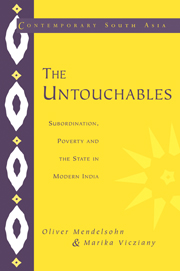Book contents
- Frontmatter
- Contents
- List of tables
- Glossary
- Preface
- 1 Who are the Untouchables?
- 2 The question of the ‘Harijan atrocity’
- 3 Religion, politics and the Untouchables from the nineteenth century to 1956
- 4 Public policy I: adverse discrimination and compensatory discrimination
- 5 Public policy II: the anti-poverty programs
- 6 The new Untouchable proletariat: a case study of the Faridabad stone quarries
- 7 Untouchable politics and Untouchable politicians since 1956
- 8 The question of reservation: the lives and careers of some Scheduled Caste MPs and MLAs
- 9 Subordination, poverty and the state in modern India
- Bibliography
- Index
2 - The question of the ‘Harijan atrocity’
Published online by Cambridge University Press: 05 June 2012
- Frontmatter
- Contents
- List of tables
- Glossary
- Preface
- 1 Who are the Untouchables?
- 2 The question of the ‘Harijan atrocity’
- 3 Religion, politics and the Untouchables from the nineteenth century to 1956
- 4 Public policy I: adverse discrimination and compensatory discrimination
- 5 Public policy II: the anti-poverty programs
- 6 The new Untouchable proletariat: a case study of the Faridabad stone quarries
- 7 Untouchable politics and Untouchable politicians since 1956
- 8 The question of reservation: the lives and careers of some Scheduled Caste MPs and MLAs
- 9 Subordination, poverty and the state in modern India
- Bibliography
- Index
Summary
For thirty years after Independence the Untouchables were no more than a marginal issue in India. Then, almost immediately after the cessation of Indira Gandhi's Emergency in 1977, the matter of their connection with violence suddenly became the stuff of front-page news. A series of particularly gruesome ‘Harijan atrocities’ genuinely shocked national opinion makers. In the present context we need to ask whether these incidents, and the routinely high level of violence apparently suffered by Untouchables, is the summation of age-old subordination or whether it arises from a new consciousness and resistance on their part. In trying to answer these questions we are setting out to present just one more image, albeit an important one, of the contemporary condition of Untouchables. We should resist the temptation to see this violence as the distilled essence of the whole historical system of Untouchability. But at the same time, violence may be able to point us towards powerful currents moving beneath the surface of Indian life.
Reportage of violence done to Untouchables is a recent affair, as can be seen from the reports of the Commissioner for Scheduled Castes and Scheduled Tribes (RCSCST). As the Constitutional authority charged with measuring the progress of the Scheduled Castes (Article 338), the Commissioner has been reporting on ‘complaints’ since the Sixth Report of 1956–7. In that Report the Commissioner provided six examples of what he considered to be justified complaints in the scant two pages he devoted to the topic.
- Type
- Chapter
- Information
- The UntouchablesSubordination, Poverty and the State in Modern India, pp. 44 - 76Publisher: Cambridge University PressPrint publication year: 1998
- 1
- Cited by



